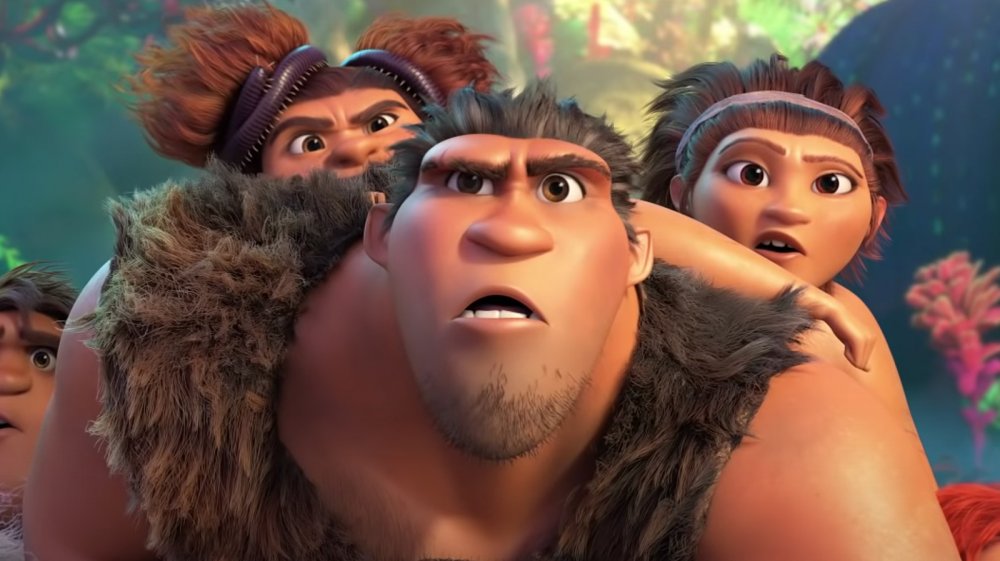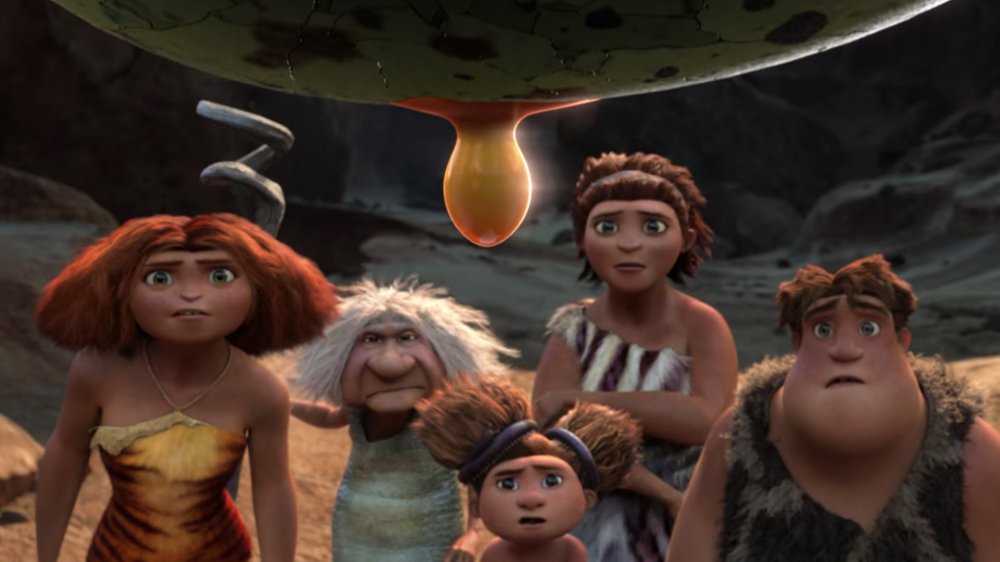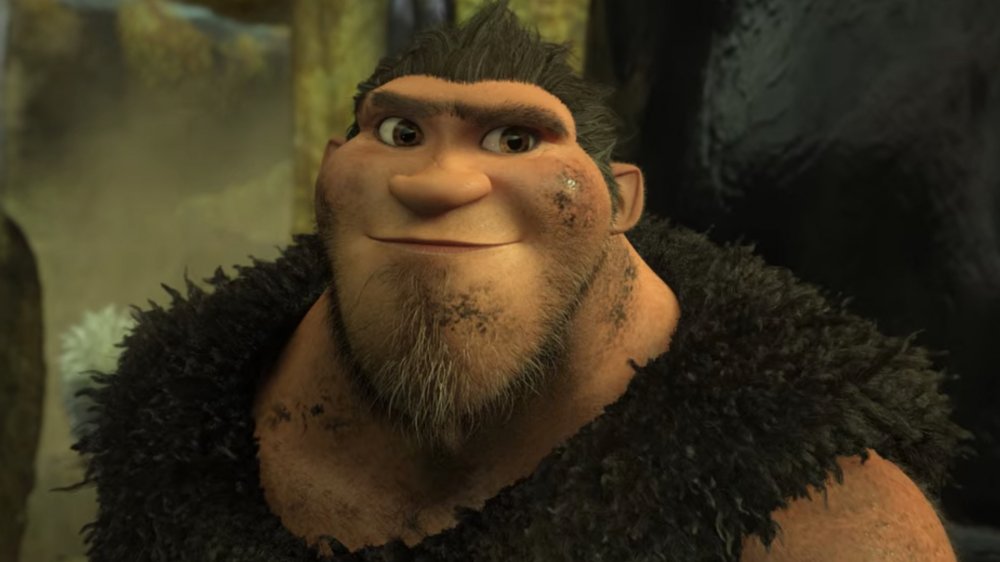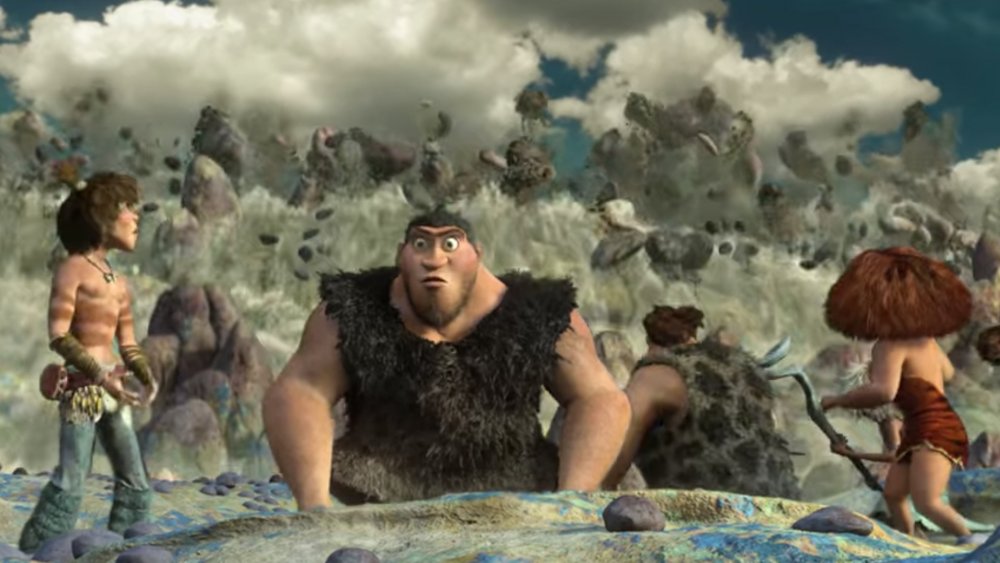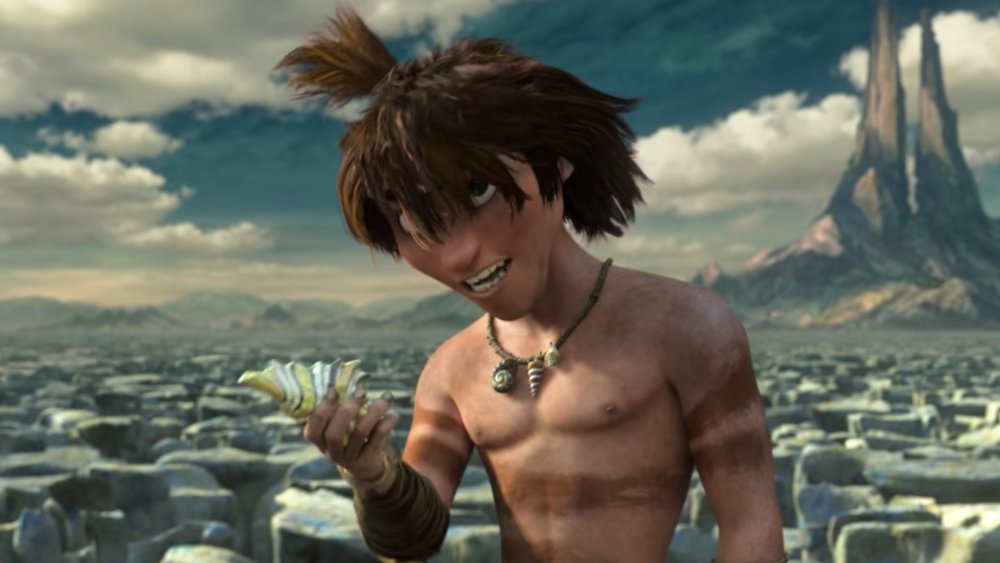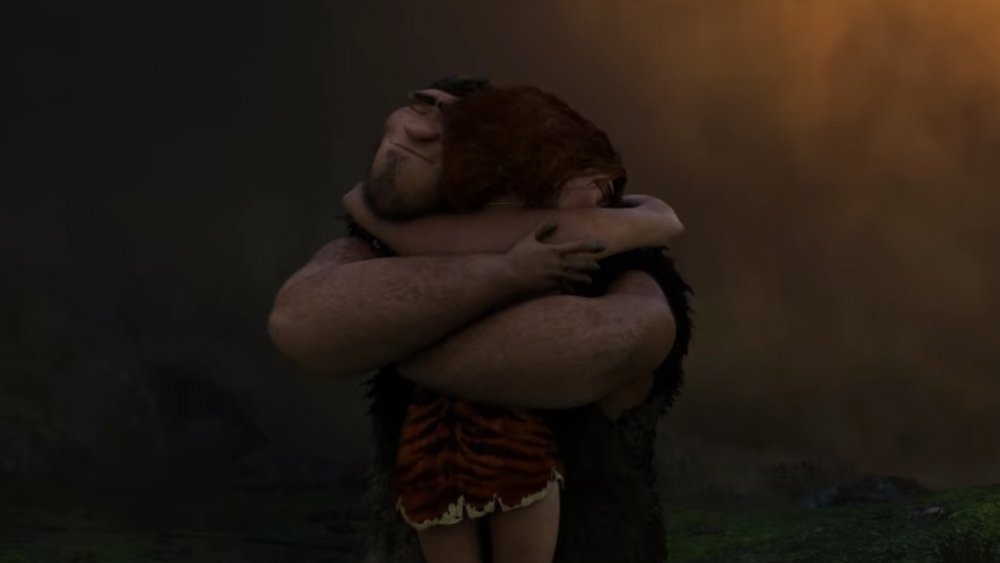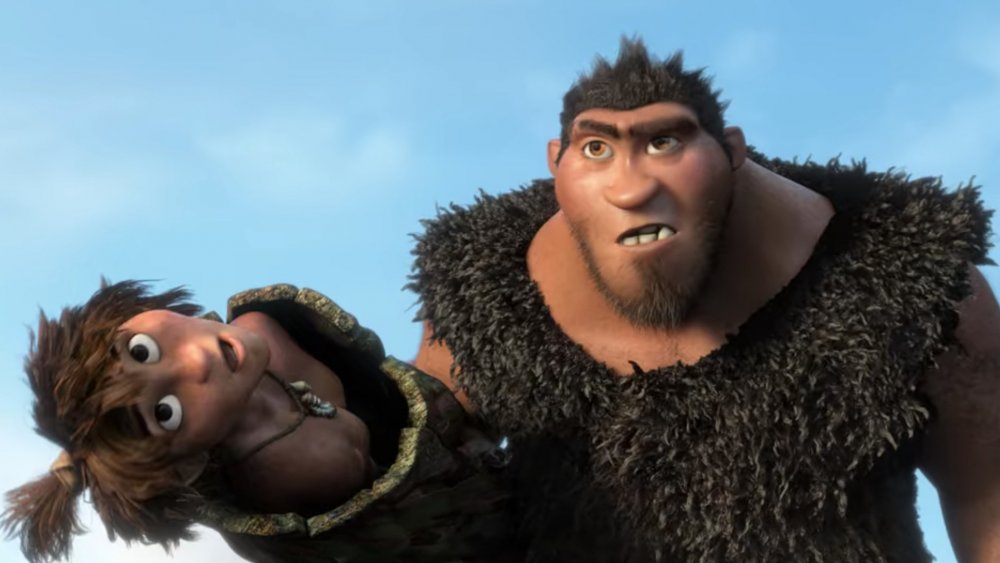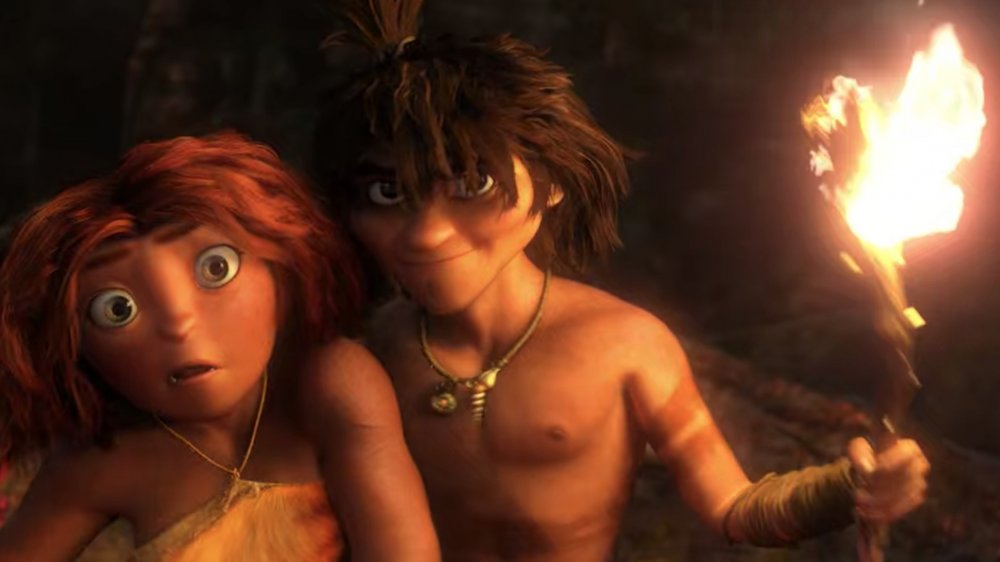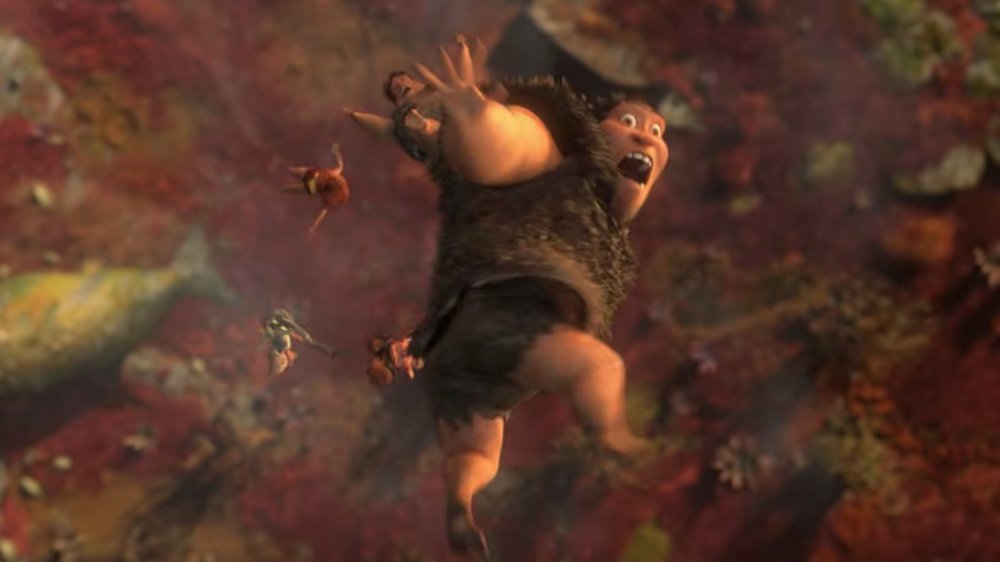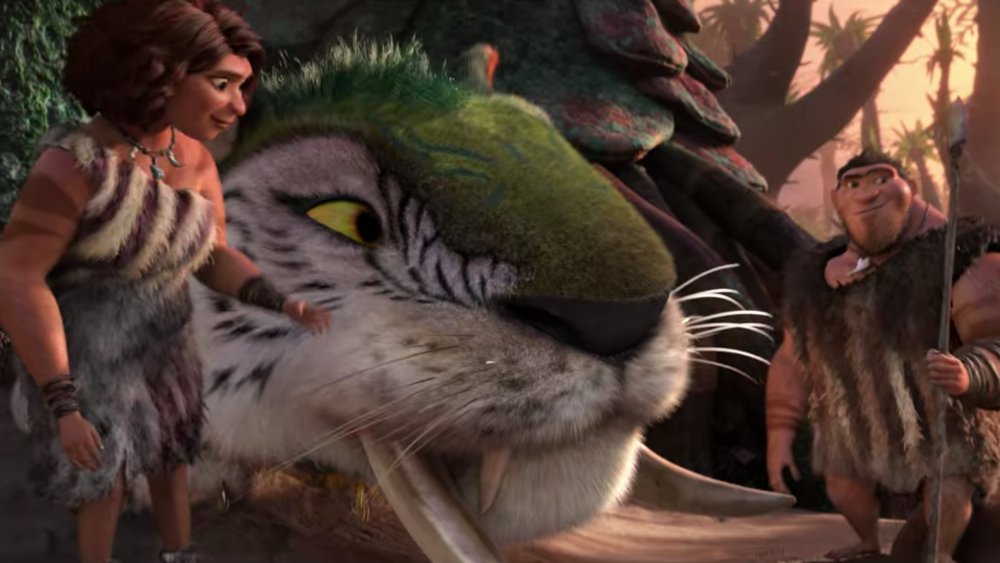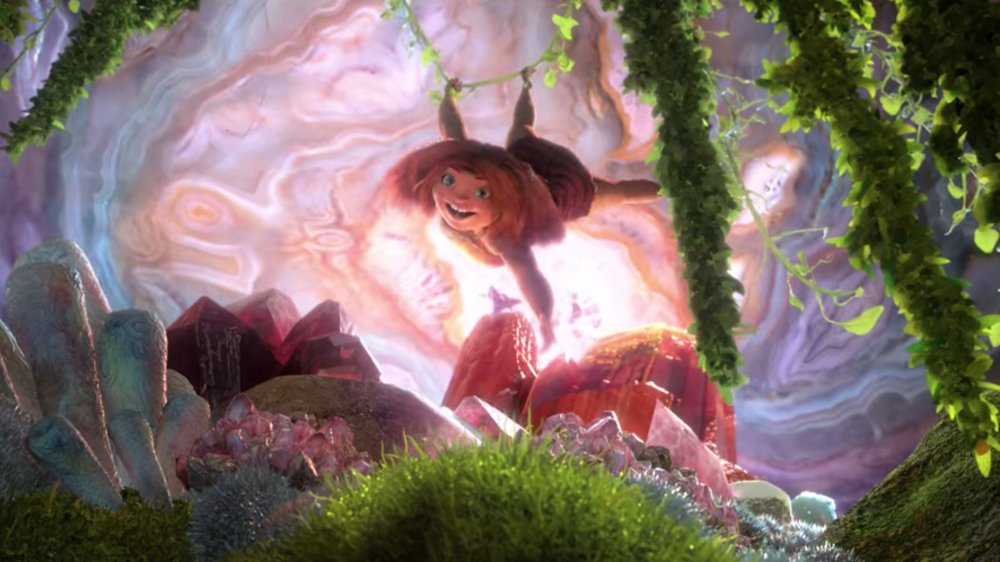Things Only Adults Notice In The Croods
Released in 2013, The Croods tells the story of a caveman family that's hidden away from the world. But when they encounter a guy with a man bun who's got some wild ideas, they realize an Earth-shattering catastrophe is on the way, and perhaps it's time to face the wide, scary world. This playful animated film was a smash, raking in over $500 million worldwide and boasting a 71% on Rotten Tomatoes, which isn't too shabby. And even though it's set in a whimsical fantasy version of the Paleolithic era, it's still grounded in the real world.
This prehistoric family squabble has all the bonks and yelps needed to keep kids planted firmly in the living room, safe and sound. After all, The Croods is a children's film meant to be taken at face value and enjoyed for the pretty colors and goofy antics. There's a kid in all of us, though, and parents need a laugh, too. And if they decide to watch this caveman family traipse their way through treacherous jungles, they might pick up on a few things that their kids won't get. From caveman strength to Paleolithic physics, here are some things that only adults notice in The Croods, probably because we know what's really outside the cave.
The Croods can maintain superhuman strength by eating once a week
The environment the Croods reside in is stark and barren. It's a dusty wasteland occupied by feisty birds and a cat-owl hybrid with a caveman vendetta. Don't sweat it though, kiddos, our ancestors are mighty and resilient. They can throw massive stones and run like the wind. It's a cartoon smorgasbord of Wile E. Coyote shenanigans. However, in the first few minutes — after an outstretched hall-of-fame catch sends him sliding headfirst into a boulder — the family's patriarch, Grug (Nicolas Cage), throws out a light-hearted quip that will have parents raising an eyebrow or two.
After fighting tooth and nail for their breakfast (one big egg), Grug ends up only getting a smidgeon of a portion by the time the family has had their fill. "Eh, it's okay. I ate last week," he states. Contextually, the joke works and sets a fun tone. But given all their physical advantages, it's surprising that the Croods are able to maintain their hulkish physiques eating only one egg per week. They need to eat in order to survive, and that's made clear throughout the journey. Maybe it's the caveman DNA because once we meet Guy (Ryan Reynolds), he's a bit leaner and not nearly as strong as any of the Croods. That's an interesting fact given that he has an easier time getting food and even introduces them to the concept of "leftovers."
Grug is extremely needy
The leader of the pack is the steadfast father figure, Grug, and he's done what every parent hopes to achieve — he's kept his children alive by instilling in them a perpetual fear of everything. Granted, it comes from a nurturing place. Considering we believe them to be the last caveman family — and every other family around them has succumbed to the horrors of their world — it's reasonable that he chooses to lead this way.
But is this almighty man of the loincloth content in his role as beefcake supreme? Of course not. Any deviation from his plans causes him to become frantic. He's so overbearing that Ugga (his wife, voiced by Catherine Keener) has to physically put her hands on him and push him away at one point. Good thing there's some modicum of modern family roles in this Stone Age family, otherwise this adventure could've gotten dark.
With their circumstances, there are unfortunate attributes that need to be overlooked for the sake of survival (of the species). Grug's incessant neediness is one of them. He needs his hand held through most of the film. When it comes time to sink or swim, we watch Grug sink to the bottom of a lake with all the melancholy a primitive mind can muster. Kids will think Grug is being a goofball. Adults will empathize with his plight. And everyone will feel like he's smothering them.
The apocalypse will occur at a comfortable walking pace
The Croods is a movie meant for kids, which means that it has to tread carefully with its apocalyptic plotline. After all, we don't want to scare the children with a devastating global catastrophe. However, we do have a linear story that needs to be told, and we need to feel a sense of urgency. Not that any of the kids are inquiring as to what exactly our titular heroes are running from. "It's the end of the world. Dun dun dunnnnn!" Belt's (Chris Sanders) rhythmic narration of the end times gives all the explaining necessary for any toddler brains analyzing the story structure.
For those of us with more developed frontal lobes, a quick animated insert hints to the fact that the continents are shifting. Given we're seeing the ground split and ash rain from the sky, this seems about right. The whole process occurs at an annoyingly convenient pace, though.
Several montages of beautiful scenery hint that many miles of ground are covered while the planet holds back more lava burps. It's a bit too favorable that massive tectonic shifts in the Earth are occurring at a convenient walking pace. The world-altering catastrophe appears to have a mind of its own, as well as a say in story progression. At times, the disaster nudges the Croods further into new territory. If only reality were like this. We can't even get our GPS to nudge us towards the gym.
The Croods can find as many conch shells as they need before ever seeing the ocean
The human vocal range, unfortunately, has its limits. We can only shout for so long, and our voices can only reach so far. Good thing our ancestors wrapped their lips around the husks of abandoned snail houses and discovered the booming might of the conch. It would appear the ancient founder of the first megaphone was none other than Guy.
The conch shell is formed by aquatic snails and is mostly found near large water sources. To find one anywhere but the ocean is extremely rare and usually means that an ancient waterway once existed there. And at the end of The Croods, our heroes all reach the ocean and venture onward into the next chapter of their story. The fact that this is their final destination in the film implies everyone had yet to reach the ocean prior. So how is it they possess so many of these conch shells? Guy is handing 'em out like candy.
Even the most inquisitive kid may be surprised at the surplus of conch shells that Guy has in his satchel when they're setting off into a labyrinth of tunnels. Guy may be an idea man, but he still possesses the naivety to believe he can actually catch the sun (as endearing as the metaphor is). Chances are he hadn't spent a lot of his time alone out in a different ocean, farming for conch shells.
There is no word for 'hug' yet, but there's a word for 'love'
In the supposed final moments of Grug's time with his family, he sums up everything that Eep (Emma Stone) and him need to talk about beautifully. It's the most succinct the moment could possibly be, with the caveman pulling his daughter in for a hug. She then inquires as to the name of this new comforting invention. He declares that it will be called "a hug because it rhymes with Grug." It's a misty-eyed moment that ends in a father telling his daughter he loves her. The kids have probably checked out on the mushy stuff at this point, but adults probably are asking how the heck there's a word for something as complex as "love" but not something as straightforward as a "hug."
Cavemen are extremely literal, as displayed by Eep's innocent assumption that fire is alive because Guy said it was "dying." The words they use are attached to actions and things — caves, rocks, run, smash, etc. It's cute to have "hug" be introduced into their lexicon — thus displaying Grug's contribution and evolution — but anyone who's had their heart put through the ringer knows "love" is a drastically more complex word to process. It feels like a missed opportunity to build on the formula and bring in the Neanderthals' interpretation of the emotion. Maybe the film's creators felt like that would be too much mushy stuff. Anyone trying not to cry in front of their kids when the Croods all pay tribute to their fallen patriarch will agree.
The cultural similarities in The Croods are noticeable
It's unlikely that children are keying in on metaphors when they're indulging in a visual blitz of colors and silliness, but adults may have a hard time not seeing cultural similarities between our world and the caveman world running through The Croods. It's all the more obvious with Nicolas Cage stepping in as the dad who won't change with the times. His dry, annoyed drawl helps the movie drive its point home — adapt or slip into a crack in the ground and melt into a river of magma.
There's another character whose visual attributes also help make things apparent, and that's Guy, of course. The scrawny idea factory's representation of progress is visualized, with a healthy dose of snark, by his man bun. The hairstyle is a telltale sign of the liberal hipster, especially considering when the movie was released (2013). Guy innocently posits a better approach to situations they have long dealt with, but he lacks the leadership that comes from years of fighting off predators with your fists. And it's not that Grug or Guy are wrong about their approaches — they're just different. If any parents are upset with the representation of either side, then they're looking at the entire film all wrong. After all, our heroes reach their new paradise by working together. Each of them grows in their own way and learn an unfortunate lesson in the process — mother-in-laws are immortal, and you best just get used to them.
Guy can make fire incredibly fast
Anyone who's taken part in a Boy Scout camping trip and felt a primal rage bubble up from within while they spin sticks between kindling, well, they might have some major issues with the way The Croods deals with fire. Trying to master the strike of flint is an incredibly annoying endeavor, but evidently, Guy doesn't have an issue sparking up some flames in a heartbeat in the middle of stressful situations. Heck, he can create a fire strong enough to withstand the wind gusts of thousands of carnivorous birds.
Child audiences are no doubt unaware of the woes of campfire construction, as camping entails electrical outlets and parking spaces nowadays. Those of us who endured the "joy" of camping in the middle of nowhere know how difficult the fire-building process can be. We'll let it slide, though. After all, it's more enjoyable to see how things pan out for the Croods instead of them getting mauled by the wave of flesh-eating ancestors of Toucan Sam. It also makes the family's introduction to Guy and the concept of fire a majestic experience.
The Croods are immune to falls
The zany Looney Tunes tomfoolery of The Croods injects the proper amount of innocence into what might otherwise be a boring tale about how even Nicolas Cage can change. However, the film begins to stretch it a bit far at points. It's a child's animated film, and we're trying not to nitpick, but right around the time Grug grabs the family and leaps off a cliff, most adults are spitting out their chardonnay, completely flabbergasted that they all could survive a fall from the equivalent of a skyscraper rooftop.
Well, it's a good thing that cavemen are immune to falls, apparently. Especially Gran, who can take quite a beating for an elderly woman in need of a walking cane. The first time we see the family hunt, the roles are decided by Gran (Cloris Leachman) being substituted for the role of a quarter, and she's tossed into the air in a game of heads or tails. In any animated adventure, a few falls are expected, and they induce the necessary giggles. But The Croods stretches it to the point of incredulity. They fall a lot. The family members are launched into the sky by a whale geyser and land on their faces in a field. They fall into giant mazes after the ground decides to suddenly explode. They even get slingshotted into the air by trap mishaps. But every time they fall, they just get right back up ... oh ... okay, that's a cute message. Well played, filmmakers.
It's really easy to tame animals
In the real world, it takes much longer than we'd like to teach a cute little puppy that the rug is not an appropriate place to drop off a fresh loaf. It took Siegfried and Roy even longer to tame their famous tigers, and even then, one of them decided to attack Roy in the middle of a show. In other words, adults are all too aware of nature's primal indifference. Kids are spoiled by generations of species' taming and most likely haven't been kicked by a mule while trying to get fresh milk for their Fruity Pebbles. So, when the Croods amass a healthy arrangement of pet friends by the end of their journey, the little ones don't even bat an eyelash.
According to our favorite cave-dwelling family unit, animals are shockingly easy to tame in the Paleolithic era. The Croods even gain a mount in the form of the hellish owl-cat that was hunting them at the beginning of the film. But there's no explanation as to how they tame that beast. The implication is that animals come with a built in "pet" setting. The only thing you need to do in order to flip that switch is to not run away screaming.
The world of The Croods looks a lot like Avatar
When the walls of The Croods' little ravine suddenly comes smashing together, they lose their cave — the only safe hideaway they've ever known. To the amazement of the family (and the centuries of ancestral spirits, no doubt), just behind their cave walls is a vibrant jungle. All it took was tectonic calamity to expose them to the world of James Cameron's Avatar. Obviously, they aren't actually on the mystical moon of Pandora, but the environment is lush and colorful enough to make you think that a rich vein of unobtanium runs beneath the surface.
Not to say animators took a page from the Cameron Bible, but the vivid colors all breathe a certain familiarity into the jungle. Kids respond to bright, colorful images, so we can't claim the market has been cornered on the color spectrum. But the creatures we come across don't help differentiate from the two worlds, like the flock of dual-winged birds flying over the beach in the final sequences. Giant rideable tigers and vibrant, sentient flowers also help The Croods' world feel reminiscent of Pandora. Most likely, it's just us jaded adults being unable to enjoy new things and connecting with Grug too much. After all, no one's got a monopoly on pretty colors. Still, if you squint, it's hard to tell the difference between the two films.
